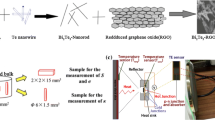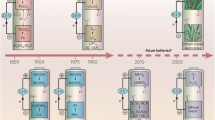Abstract
Quenching rate of the order of 105 K/s has been achieved using a home-built twin-roller rapid quenching setup which is two orders of magnitude higher as compared to the rate possible through conventional quenching methods. The glass forming limit for the two ternary glassy electrolytes Li2O–B2O3–P2O5 and Li2O–Nb2O5–P2O5 has been extended using the twin roller setup by incorporating mol% 66.7 and 50 of the glass modifier (Li2O) in the above glass systems. Further, the effect of mixed glass formers B2O3–P2O5 and Nb2O5–P2O5, investigated in the above extended glassy systems, reveal an initial increase in the glass transition temperature (Tg) and ionic conductivity (σdc), as one glass former replaces the other. The Tg and σdc show maximum values for the compositions mol% 66.7Li2O–33.3[0.6B2O3–0.4P2O5] and mol% 50Li2O–50[0.6Nb2O5–0.4 P2O5], indicating the “mixed glass former effect”. The composition mol% 66.7Li2O–33.3[0.6B2O3–0.4P2O5], showing good thermal stability as well as conductivity, is a potential electrolyte material for device applications.








Similar content being viewed by others
References
Minami T, Hayashi A, and Tatsumisago M, Solid State Ionics 177 (2006) 2715.
Chen H S, and Miller C E, Rev Sci Instrum 41 (1970) 1237.
Pradel A, Pagnier T, and Ribes M, Solid State Ionics 17 (1985) 147.
Tatsumisago M, Saito T, and Minami T, J Non-Cryst Solids 293–295 (1987) 10.
Ramesh K, Sangunni K S and Gopal E S R, J Instrum Soc India 34 (2004) 38.
Anantha P S, and Hariharan K, Mater Chem Phys 89 (2005) 428.
Tatsumisago M, Machida N, and Minami T, J Ceram Soc Jpn, 95 (1987) 197.
Christian J, and Nazri G-A, Solid State Batteries: Materials Design and Optimization, Kluwer Academic Publishers, Massachusetts (1994) p 235.
Dabas P, and Hariharan K, AIP Conf Proc 1447 (2012) 539.
Money B K, and Hariharan K, Appl Phys A 88 (2007) 647.
Raguenet B, Tricot G, Silly G, Ribes M, and Pradel A, J Mater Chem 21 (2011) 17693.
Kim S H, Yang Y S, Kim H J, Kang M S, and Jang M S, Jpn J Appl Phys 34 (1995) 4842.
Balaya P, and Sunandana C S, Solid State Commun 70 (1989) 581.
Ahn J-H, Paek Y, Shin H S, and Kim Y J, J Metastable Nanocrystalline Mater 20–21 (2004) 739.
Dygas J R, Misztal-Faraj B, Florjańczyk Z, Krok F, Marzantowicz M, and Zygadło-Monikowska E, Solid State Ionics, 157 (2003) 249.
Acknowledgments
Authors thank Mechanical workshop, Department of Physics, Indian Institute of Technology Madras for fabricating the twin-roller rapid quenching setup.
Author information
Authors and Affiliations
Corresponding author
Rights and permissions
About this article
Cite this article
Dabas, P., Hariharan, K. Rapid Quenching Setup: Design, Development and Applications in Solid State Ionics. Trans Indian Inst Met 66, 343–348 (2013). https://doi.org/10.1007/s12666-013-0275-5
Received:
Accepted:
Published:
Issue Date:
DOI: https://doi.org/10.1007/s12666-013-0275-5




